Steel Yourself: Industrial Kitchen Islands Are On a Roll
http://decor-ideas.org 11/09/2013 20:40 Decor Ideas
The almighty kitchen island functions in many ways, not the least of which is acting as command central. A customized version, like any of the clever rolling industrial styles below, offers that same high function, but thanks to their added features and bold aesthetics, they run circles around the traditional built-in island.
Not surprisingly, a kitchen shown on Houzz featuring such an industrial-style island constantly gets the question, How did the designer make that? I went to some of the creators directly for tips on how you, too, can have something like these islands in your kitchen.
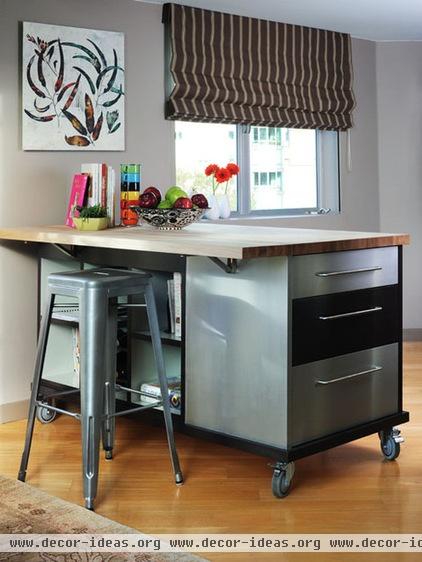
A design collaboration. Anastasia Faiella, founder of Faiella Design, has fielded lots of questions about this piece she made in collaboration with Jason Lees Design and decorative painter Ted Somogyi. The name of the game is aesthetics. “The paint colors were carefully selected to coordinate the kitchen with its shared dining room space,” says Faiella.
While beauty is key to this design, so too is functionality. The top is butcher block, and the wheels have a locking mechanism to prevent rolling away. The drawers are accessible from the side so as not to fight with the stool.
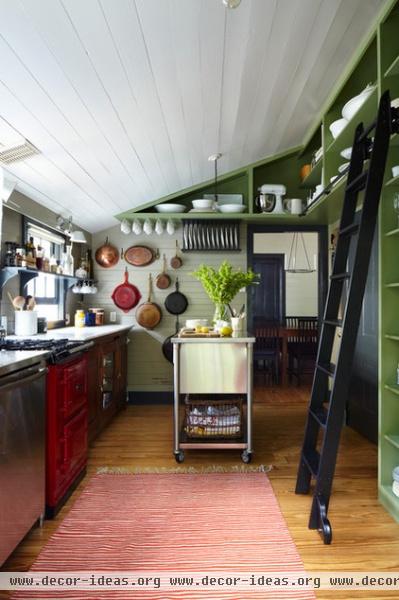
Form follows function. Architect Tim Cuppett designed this piece to fit the explicit needs of the homeowner. “Always start with function first,” he says. “Materials and details can be altered to fit any desired style.”
His stainless steel design was made by a local commercial kitchen equipment fabricator. “In addition to having drawers and an open shelf below," he says, "it's on casters so that it can be rotated and used as a serving bar, keeping people out of the cook’s way.”
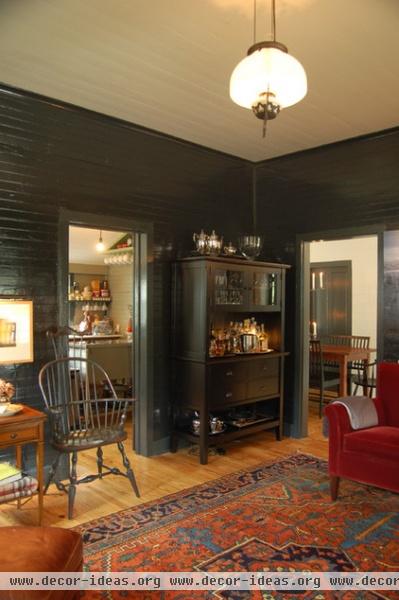
A view from the historic house’s living room shows the usefulness of the same island, which can roll through the living and dining areas carrying drinks or food.
When deciding what size to make an island of this nature, be mindful of necessary clearances. In this case the clearances include both kitchen traffic lanes as well as the doorways it needs to pass through.
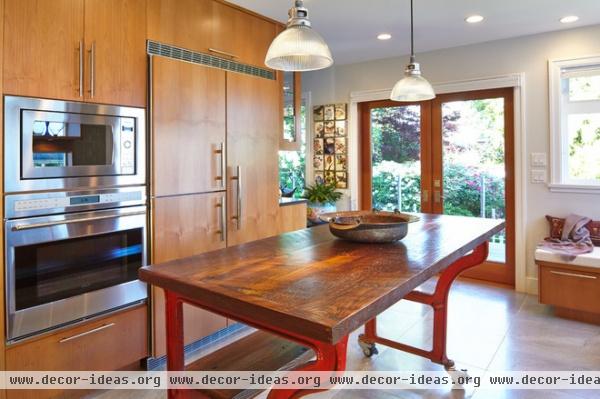
Where to start. So you want an industrial-style island, but you don’t know where to begin. “Start with a local commercial kitchen supplier," Cuppett suggests. "They may have manufactured units for sale.”
You can also dig around Houzz’s database of furniture makers for a professional in your area.
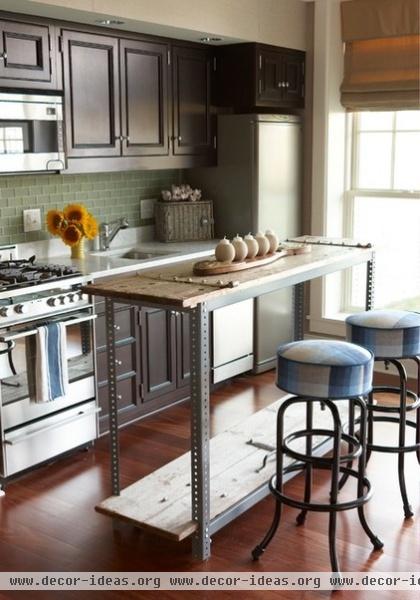
The DIY route. Or you could make it yourself, as Samantha Knapp did. Rather than commissioning this piece to be fabricated by someone else, the self-proclaimed "picker" went directly to her local upscale recycling center and found these vintage cupboard doors.
She paired the doors with a base from Uline, which cost about $100. “I deep cleaned the doors and sanded some of the finish off to create a smooth surface,” she describes. “The doors were varnished, then mounted onto the existing frame.”
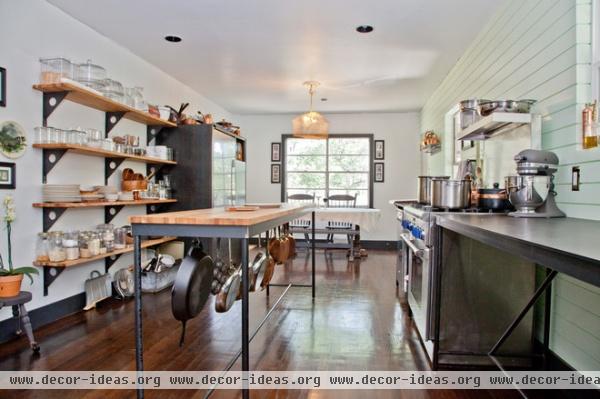
Use what you have. For this project Philip Burkhardt, Design Build Adventure’s project manager, used schedule-40 steel pipe, steel angle and some reclaimed oak planks that his client had sitting around. They were “all very affordable options that came together nicely,” he says. “Our bias is to keep a piece like this simple. The more you try to make the island do, the more difficult it becomes to resolve the details elegantly.”
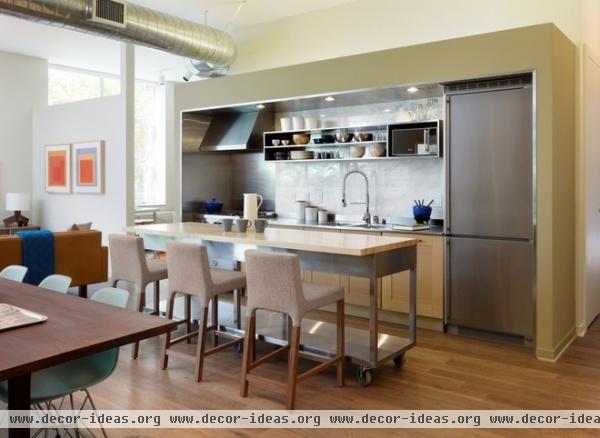
Consider your space. “The first thing to consider when determining the island’s style is the space where the island is going,” says Burkhardt. “Above all else it needs to fit its space, allow proper circulation and add to the function of the kitchen.”
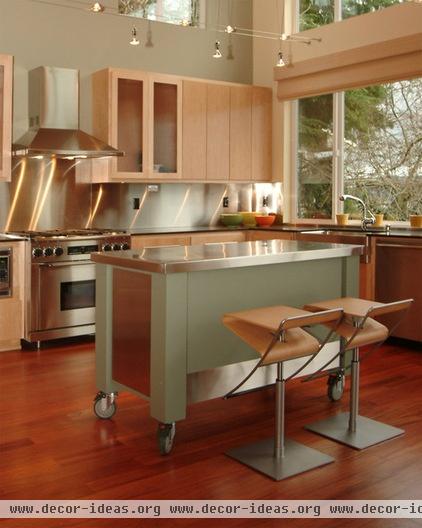
Architect Dan Nelson and designer Garrett Kuhlman collaborated on this island constructed of paint-grade wood and stainless steel, which Kuhlman says "protects the island from heavy use by kids, guests and the family pets.”
This sort of forethought about how the island will be used (and possibly abused) over the years helps a designer make a long-lasting piece.
What to discuss with your designer to get the right island:
1. Anticipated use. This will dictate what materials will work best. If you’ll be using it as a baking station, a stone top is a great choice. If you’ll be using it as a cutting board, go for a wood top instead. If you’ll be using it as a serving cart, go for stainless steel; it will weather spills and run-ins with walls and furniture.
2. Size. “An island can be as small as 30 by 30 inches, and any length," Kuhlman says. "But if an island gets too deep — say, with seating on one side — a host may not be able to reach across to service guests.”
3. Seating. “For seating, an overhang of 15 inches is a good minimum," Kuhlman says. "It helps conceal stools when not in use and keeps your guests' knees from knocking on the face of the island. The height of a raised bar area on an island shouldn’t exceed 42 inches to keep it comfortable for dining and casual seating.”
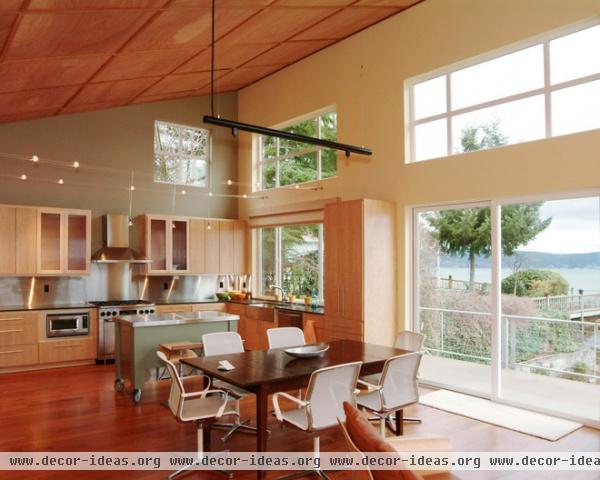
4. Clearances. Kuhlmann suggests having at least 42 to 48 inches between an island and adjacent cabinetry for adequate circulation. More may be needed around appliances with doors.
5. Casters. If you want your island to be movable, casters are the ticket. Just don’t forget a wheel-locking mechanism to help prevent accidents.
“A rolling eat-at island has the unique ability to connect diners with whatever view is most appropriate at the moment,” Nelson notes.
This kitchen takes full advantage of its waterfront views. However, when that view isn't the desired focus, the island can be instead directed at the dining area or the living room, or the … well, you get the idea. That's something a traditional built-in island just can't do.
Your turn: Show us your ingenious industrial-style island in the Comments!
More: Find rolling kitchen islands and carts in the Products section
Related Articles Recommended












